Most households in the United States have some sort of medication, either prescription or OTC, in them. These medications should be disposed of when they expire or are no longer wanted or needed, but patients often have questions regarding the proper way to dispose of them. Pharmacists should recommend proper disposal guidance and explain the possible consequences of improper disposal.
Why Proper Disposal Matters
Disposing of medications appropriately helps prevent environmental contamination of water and soil. Pharmaceuticals and their metabolites found in the environment have been shown to negatively affect fish and other wildlife. Examples include animals’ ability to reproduce, alterations in behavior, and direct toxic effects. Effects on humans include interactive effects, bioaccumulation of certain substances, and an increase in antibiotic resistance.1
About the Author
Kathleen Kenny, PharmD, RPh, earned her doctoral degree from the University of Colorado Health Sciences Center. She has more than 30 years of experience as a community pharmacist and works as a clinical medical writer based out of Albuquerque, New Mexico.
Improper medication disposal may also lead to misuse or abuse. Individuals with substance abuse disorders can find disposed medications and use them or sell them, leading to addiction, overdose, or other health problems. Accidental poisoning of children or pets can also occur, leading to serious consequences.2
Best Practices for Disposal
American households have several options when it comes to safely disposing of unwanted household medications3-5:
- Drug Enforcement Administration (DEA) Take Back Days: The US DEA conducts twice-yearly National Prescription Drug Take Back Days, in April and October. These Take Back Days also accept OTC medications. In April 2025, it had 4590 collection sites across the country and collected 310 tons of medications, bringing its all-time total to 9910 tons.
- Pharmacy kiosks: Many pharmacies, especially national chains, offer drug take-back kiosks where unwanted, unused, and expired medications can be safely disposed of. These kiosks are open to the public and are free to use. Collected medications are taken to incineration facilities in cooperation with the DEA.5
- Law enforcement kiosks: Some law enforcement agencies support permanent take-back kiosks. When used, these kiosks aid in safe drug disposal while conserving law enforcement resources. Patients should be directed to call their local police or sheriff’s station for assistance.
- Mail-back envelopes: These convenient, secure envelopes can be purchased at some retail pharmacies or online. They may also be available at no charge from certain pharmacies. The patient can obtain a prepaid mailback envelope, fill it according to the directions, seal it, and mail it to the indicated location. This is a convenient, cost-effective way to safely dispose of medications.
- Community take-backs: Community groups may sponsor medication takeback events as well; however, they are typically short-term and must have a law enforcement officer in attendance.
- Disposal at home: As a last resort, if there are no other take-back or mail-back options available, medications can be thrown away after completing the following steps: First, take prescription drugs out of their original containers. Mix the medications with an absorbent, undesirable substance, such as cat litter, sawdust, or coffee grounds. Place the mixture in a sealable container, such as a plastic container or a sealable bag. Conceal or remove any personal identifying information from the containers. The drug mixture in the sealed container as well as the original containers may now be placed in the trash.
Call to Action
Pharmacists play a critical role in promoting the safe and responsible disposal of medications. Pharmacists are encouraged to counsel patients on the consequences of improper drug disposal and educate them on the safe options available, including take-back programs, mail-back envelopes, and proper home disposal methods.
Participation in take-back programs is essential, with pharmacists actively promoting these initiatives by providing information and directing patients to the most convenient collection locations. For pharmacies that maintain a drug take-back kiosk, it is important to ensure secure collection by keeping the kiosks locked when the pharmacy is closed, promptly emptying them when full, and scheduling timely pickups.
In addition to supporting take-back efforts, pharmacists should educate patients on how to securely dispose of medications at home, offering guidance on the materials and methods to prevent unauthorized access. Staying current with regulatory requirements related to pharmaceutical waste disposal is also vital to ensure compliance. Lastly, pharmacists should consider offering mail-back envelopes at no charge to provide patients with a convenient and secure alternative to other disposal options.
REFERENCES
1. The impact of pharmaceuticals released to the environment. United States Environmental Protection Agency. Updated November 14, 2024. Accessed June 6, 2025. https://www.epa.gov/household-medication-disposal/impact-pharmaceuticals-released-environment
2. Insani WN, Qonita NA, Jannah SS, et al. Improper disposal practice of unused and expired pharmaceutical products in Indonesian households. Heliyon. 2020;6(7):e04551. doi:10.1016/j.heliyon.2020.e04551
3. What to do with unwanted household medicines. United States Environmental Protection Agency. Updated March 28, 2025. Accessed June 6, 2025. https://www.epa.gov/household-medication-disposal/what-do-unwanted-household-medicines
4. Take Back Day. United States Drug Enforcement Administration. Accessed June 6, 2025. https://www.dea.gov/takebackday
5. Drug disposal: drug take-back options. FDA. Updated October 31, 2024. Accessed June 6, 2025. https://www.fda.gov/drugs/disposal-unused-medicines-what-you-should-know/drug-disposal-drug-take-back-options







